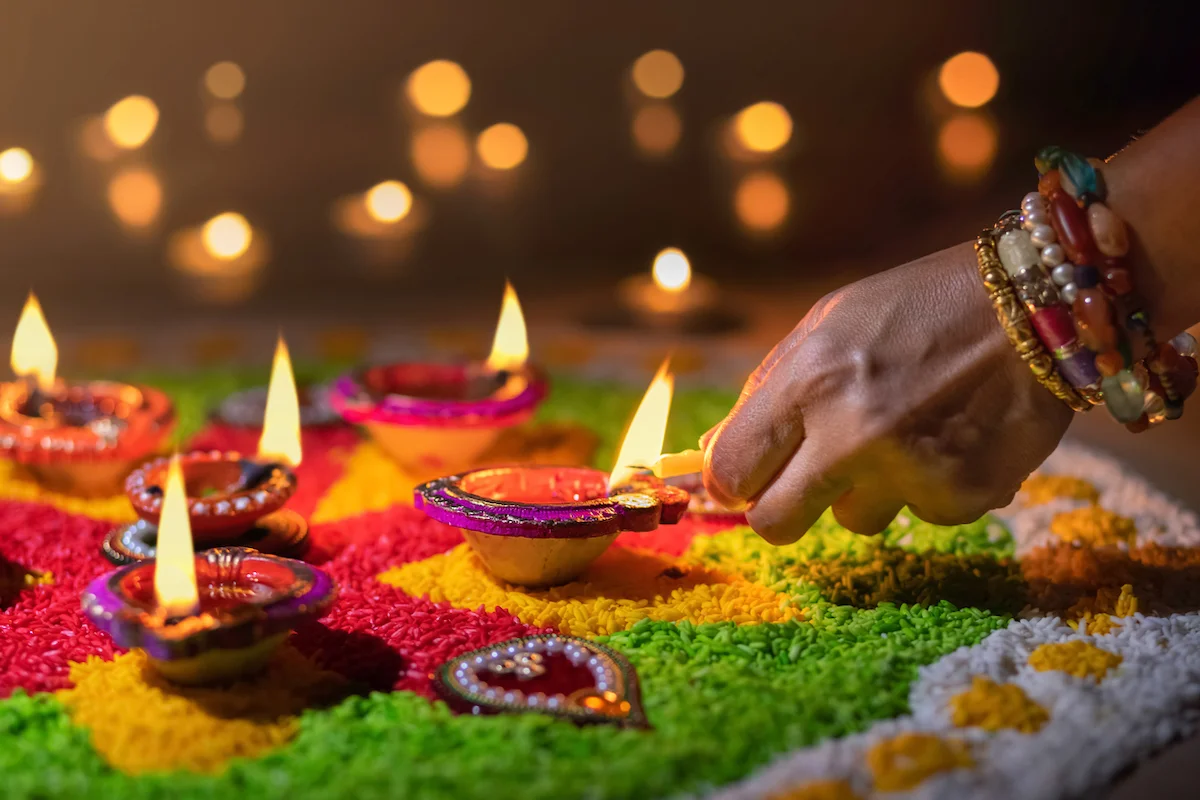Diwali: The Festival of Lights
Introduction
Diwali, also known as Deepavali, is one of the most significant and widely celebrated festivals in India. It is a festival that transcends the boundaries of religion, region, and culture, symbolizing the victory of light over darkness, good over evil, and knowledge over ignorance. The word “Diwali” itself is derived from the Sanskrit word “Deepavali,” which means “a row of lamps.” This essay explores the origins, significance, rituals, and contemporary celebration of Diwali, emphasizing its profound impact on Indian culture and society.
Historical Origins of Diwali
The origins of Diwali are rooted in various mythological and historical events, making it a festival with a rich and diverse history. The most popular legend associated with Diwali is the return of Lord Rama to his kingdom Ayodhya after a 14-year exile. According to the Hindu epic Ramayana, Rama, along with his wife Sita and brother Lakshmana, defeated the demon king Ravana, symbolizing the triumph of good over evil. The people of Ayodhya, in joyous celebration of their king’s return, lit lamps across the kingdom, marking the first Diwali.
Another legend links Diwali to the worship of Goddess Lakshmi, the goddess of wealth and prosperity. It is believed that on the night of Diwali, Lakshmi emerged from the ocean during the churning of the Milky Ocean (Samudra Manthan) and married Lord Vishnu. Thus, Diwali is also celebrated as a time to invite prosperity and abundance into homes and businesses.
In addition to these stories, Diwali is associated with the worship of Lord Ganesha, the remover of obstacles, and Lord Krishna’s victory over the demon Narakasura. In some parts of India, Diwali marks the end of the harvest season, a time to give thanks for the bounty and to seek blessings for the coming year.
Cultural Significance of Diwali
Diwali is much more than just a religious festival; it is a cultural celebration that unites people of different backgrounds. It is a time when families come together, communities unite, and the entire country is adorned with lights, decorations, and joy. The festival symbolizes the importance of inner light and the dispelling of ignorance and negativity.
The five days of Diwali each have their own significance and rituals. The first day, Dhanteras, is dedicated to the worship of wealth and prosperity. People buy gold, silver, and other precious items, as it is considered an auspicious day for making investments. The second day, Naraka Chaturdashi or Choti Diwali, commemorates Lord Krishna’s victory over the demon Narakasura, symbolizing the victory of light over darkness.
The third day, Diwali or Lakshmi Puja, is the most important and widely celebrated day of the festival. On this day, homes are thoroughly cleaned, decorated with rangoli (colorful patterns made on the floor), and illuminated with oil lamps and candles. Families perform Lakshmi Puja to invoke the blessings of the goddess of wealth. It is also a day for exchanging gifts, sweets, and greetings with loved ones.
The fourth day, Govardhan Puja or Annakut, is celebrated in honor of Lord Krishna lifting the Govardhan Hill to protect the people of Vrindavan from a storm sent by Indra, the king of gods. On this day, devotees prepare a large variety of vegetarian dishes and offer them to Krishna as a symbol of gratitude.
The fifth and final day of Diwali, Bhai Dooj, celebrates the bond between brothers and sisters. Sisters perform aarti for their brothers and pray for their well-being, while brothers offer gifts and pledge to protect their sisters.
Diwali Preparations
Preparations for Diwali begin weeks in advance, as people clean and renovate their homes, purchase new clothes, and decorate their living spaces. Cleaning the home is not just about physical cleanliness; it also symbolizes the removal of negative energies and the creation of a space that is welcoming to Goddess Lakshmi. Many families also take this time to refurbish or redecorate their homes, adding new furniture or painting the walls.
Shopping is a major part of Diwali preparations, with markets bustling with activity. People buy new clothes, jewelry, and gifts for their family members and friends. Traditional attire, such as sarees, lehengas, and kurta-pajamas, is often preferred for the occasion. The exchange of gifts is a way of expressing love and goodwill, and it strengthens social bonds.
Another essential aspect of Diwali preparations is the preparation of sweets and snacks. Traditional Indian sweets, such as ladoos, barfis, jalebis, and gulab jamuns, are made at home or bought from sweet shops. These sweets are offered to guests and exchanged with neighbors, symbolizing the sweetness of relationships.
Diwali Decorations
Diwali is known for its vibrant and colorful decorations. Homes, temples, and public spaces are adorned with lights, lanterns, and diyas (oil lamps). The lighting of diyas is a central ritual of Diwali, symbolizing the victory of light over darkness. Diyas are placed in every corner of the house, on windowsills, balconies, and in courtyards, creating a warm and inviting atmosphere.
Rangoli is another important decorative element of Diwali. It is an art form in which intricate and colorful patterns are created on the floor using colored powders, rice, or flower petals. Rangoli designs often feature geometric patterns, floral motifs, and depictions of deities. The purpose of rangoli is to welcome guests and deities into the home and to ward off evil spirits.
In addition to traditional decorations, modern Diwali celebrations also include the use of electric lights and LED decorations. Strings of fairy lights are draped over houses, trees, and buildings, creating a dazzling display of color and light. In urban areas, public buildings and monuments are illuminated, and firework displays are organized, adding to the festive spirit.
Diwali Rituals and Practices
Diwali is a festival rich in rituals and practices, each with its own symbolic meaning. The rituals begin with the lighting of diyas and candles, which are placed around the home and in temples. This practice is not only meant to illuminate the surroundings but also to symbolize the inner light that guides and protects individuals.
The Lakshmi Puja, performed on the main day of Diwali, is the most important ritual. The puja involves the worship of Goddess Lakshmi, along with Lord Ganesha, the remover of obstacles. The puja is conducted with great devotion, as families offer flowers, sweets, fruits, and other offerings to the deities. The chanting of mantras and the recitation of prayers create an atmosphere of spirituality and reverence.
Another important ritual is the bursting of firecrackers. Fireworks are an integral part of Diwali celebrations, and they symbolize the joy and excitement of the festival. The sound of firecrackers is believed to drive away evil spirits and negative energies, while the bright lights represent the victory of light over darkness.
However, in recent years, there has been a growing awareness of the environmental impact of firecrackers. Many people are now opting for eco-friendly alternatives, such as lighting lamps and using soundless fireworks, to celebrate Diwali in a way that is both joyful and environmentally responsible.
The Spirit of Giving and Sharing
Diwali is also a time for giving and sharing, a practice that is deeply ingrained in Indian culture. The festival encourages acts of charity and kindness, as people share their wealth and happiness with those less fortunate. Many individuals and organizations engage in charitable activities during Diwali, such as distributing food, clothes, and gifts to the needy.
The exchange of gifts is a central part of Diwali celebrations. Gifts are exchanged between family members, friends, and neighbors as a token of love and goodwill. These gifts often include sweets, dry fruits, clothes, and decorative items. The act of giving gifts strengthens social bonds and fosters a sense of community.
In addition to material gifts, Diwali is also a time for sharing knowledge and wisdom. Elders in the family often take this opportunity to pass down traditions and values to the younger generation, ensuring that the cultural significance of Diwali is preserved for future generations.
Diwali Celebrations Across India
Diwali is celebrated with great enthusiasm across India, but the customs and traditions associated with the festival vary from region to region. In North India, Diwali is closely linked to the return of Lord Rama to Ayodhya and is celebrated with the lighting of lamps, bursting of firecrackers, and worship of Goddess Lakshmi. The entire region is illuminated with lights, and the streets are filled with the sounds of firecrackers and the aroma of sweets.
In Western India, particularly in Gujarat and Maharashtra, Diwali marks the beginning of the new financial year. Businessmen and traders close their old account books and open new ones, seeking the blessings of Goddess Lakshmi for prosperity in the coming year. The festival is also celebrated with the lighting of lamps, the preparation of sweets, and the exchange of gifts.
In Eastern India, particularly in Bengal, Diwali is celebrated as Kali Puja, in honor of the goddess Kali. Devotees worship Kali, the goddess of power, seeking her protection and blessings. Homes and temples are decorated with lamps and candles, and elaborate puja ceremonies are conducted. In Odisha, the festival is known as “Kaunriya Kathi,” where people light jute sticks to guide the spirits of their ancestors to heaven.
In South India, Diwali is celebrated as Naraka Chaturdashi, commemorating Lord Krishna’s victory over the demon Narakasura. The day begins with an oil bath, followed by the lighting of lamps and the bursting of firecrackers. The festival is also a time for feasting, with families preparing traditional dishes and sweets to share with loved ones.
Diwali in the Modern World
While Diwali has deep-rooted cultural and religious significance, its celebration has evolved over time, especially in the modern world. Today, Diwali is not only celebrated in India but also by the Indian diaspora around the world. In countries like the United States, Canada, the United Kingdom, and Australia, Diwali has become a major cultural event, with public celebrations, community gatherings, and festive events.
The modern celebration of Diwali often includes elements of contemporary culture, such as themed parties, social media campaigns, and online shopping festivals. E-commerce platforms offer special Diwali discounts and deals, making it a peak season for retail sales. In urban areas, the festival has also become a time for socializing, with people attending Diwali parties, dinners, and cultural events.
However, despite the changes in how Diwali is celebrated, the essence of the festival remains the same. It continues to be a time for family, community, and reflection. The lighting of lamps, the worship of deities, and the sharing of gifts and sweets are practices that have been passed down through generations and continue to hold great significance in modern times.
Environmental Concerns and Sustainable Practices
In recent years, there has been growing concern about the environmental impact of Diwali celebrations, particularly the use of firecrackers. The bursting of firecrackers contributes to air and noise pollution, which can have serious health effects, especially for the elderly, children, and animals. Additionally, the use of non-biodegradable materials in decorations and the excessive consumption of resources during the festival have raised questions about sustainability.
In response to these concerns, there has been a shift towards more eco-friendly and sustainable practices in celebrating Diwali. Many people are now choosing to light traditional oil lamps instead of using electric lights, reducing energy consumption. There is also a growing trend of using natural and biodegradable materials for decorations, such as clay diyas, organic rangoli colors, and flower petals.
Furthermore, some communities and organizations are promoting the concept of a “Green Diwali,” encouraging people to avoid firecrackers and instead focus on the spiritual and cultural aspects of the festival. Educational campaigns and awareness programs have been launched to highlight the importance of celebrating Diwali in a way that is respectful of the environment and mindful of future generations.
Conclusion
Diwali is a festival that embodies the rich cultural heritage and spiritual wisdom of India. It is a celebration of light, knowledge, and community, and it has a timeless appeal that continues to resonate with people of all ages and backgrounds. Whether it is through the lighting of lamps, the sharing of sweets, or the exchange of gifts, Diwali brings people together and reinforces the values of love, compassion, and harmony.
As the festival continues to evolve in the modern world, it is important to preserve its essence and significance while adapting to contemporary challenges. By embracing sustainable practices and focusing on the spiritual and cultural aspects of Diwali, we can ensure that this festival of lights continues to shine brightly for generations to come.



